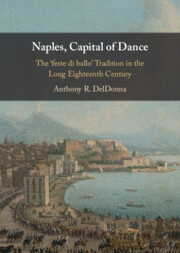Book contents
- Naples, Capital of Dance
- Naples, Capital of Dance
- Copyright page
- Dedication
- Contents
- Figures
- Tables
- Music Examples
- Acknowledgments
- Introduction
- 1 Celebratory Balls in the Kingdom of Naples
- 2 The Politics of Place and Spheres of Power
- 3 Seasons of Feste 1737 and 1747
- 4 The Dance Treatise in the Age of Reason
- 5 Seasons of Splendor
- 6 A Return to the Capital
- 7 Behind the Scenes, Between the Lines
- 8 The Neapolitan feste di ballo as (Historical) Soundscape
- Select Bibliography
- Index
7 - Behind the Scenes, Between the Lines
Music, Musicians, and maestri di ballo
Published online by Cambridge University Press: 10 April 2025
- Naples, Capital of Dance
- Naples, Capital of Dance
- Copyright page
- Dedication
- Contents
- Figures
- Tables
- Music Examples
- Acknowledgments
- Introduction
- 1 Celebratory Balls in the Kingdom of Naples
- 2 The Politics of Place and Spheres of Power
- 3 Seasons of Feste 1737 and 1747
- 4 The Dance Treatise in the Age of Reason
- 5 Seasons of Splendor
- 6 A Return to the Capital
- 7 Behind the Scenes, Between the Lines
- 8 The Neapolitan feste di ballo as (Historical) Soundscape
- Select Bibliography
- Index
Summary
Chapter 7 considers the music created for the feste di ballo. The Library of the Conservatory of Naples contains an extensive selection of eighteenth-century dance music with a clear emphasis on the minuet and contradance. Several compilations can be directly associated with specific years and members of the local musical establishment. For example, a manuscript anthology (shelf mark Od.3.10) bears the inscription “Minuetti composed for the feste of the royal palace,” positing its use for events organized in the associated dance space. It bears the name of Antonio Montoro and the date 1776, alongside a handwritten annotation citing Giovanni Battista Bergantino as an author of additional selections. Both Montoro and Bergantino had long associations as violinists with the orchestra of the Teatro di San Carlo (de facto band for the feste di ballo) and as composers of the dances for such events. Another contemporary source is a compendium of printed dance tunes by composers both local (including Luigi Marescalchi, the royal printer) and foreign (including Joseph Haydn, a favorite of the Neapolitan sovereigns). These collections provide an intimate guide to the practicalities of the feste di ballo tradition, namely a direct understanding of the music preferred and performed therein.
Keywords
- Type
- Chapter
- Information
- Naples, Capital of DanceThe ‘feste di ballo' Tradition in the Long Eighteenth Century, pp. 157 - 200Publisher: Cambridge University PressPrint publication year: 2025

